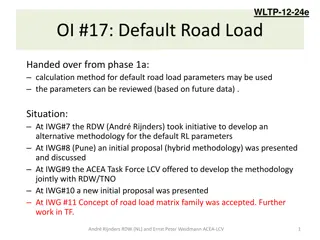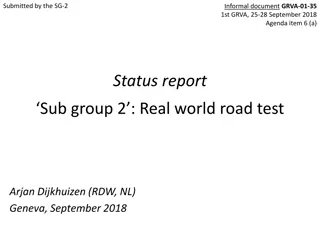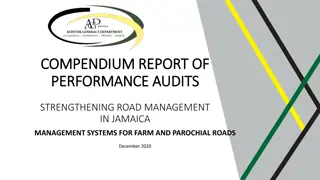
Understanding High Road Capitalism: Trends and Challenges
Explore the economic landscape of the United States at the beginning of the 21st century, including insights on family income changes, productivity trends, job growth patterns, and trade balances. Learn about the concept of High Road Capitalism and the need to shift from the low road to pave the way for a better future for both firms and workers.
Download Presentation

Please find below an Image/Link to download the presentation.
The content on the website is provided AS IS for your information and personal use only. It may not be sold, licensed, or shared on other websites without obtaining consent from the author. Download presentation by click this link. If you encounter any issues during the download, it is possible that the publisher has removed the file from their server.
E N D
Presentation Transcript
Lecture 11 Tuesday, February 21, 2017 High Road Capitalism
A Economic Balance sheet for the United States at the beginning of the 21st Century
Average real weekly earnings of private production nonsupervisory workers, 1947-2011 (2011 dollars) $700 $600 $500 $400 $300 $200 $100 $0 1947 1967 1973 1979 1982 1989 1995 2000 2007 2011
Change in family income by income group 1947-79 compared to 1979-2012 1979-2012 140% 120% 100% 75% 80% 60% 49% 40% 20% 20% 8% -12% 0% 0% -20% Lowest fifth Second fifth Third fifth Fourth fifth Highest fifth Top 5 percent
Annual growth in productivity and compensation during periods of economic expansion, 1975-2011 Median compensation growth Productivity growth 2.5 of productivity and compensation Average annualized Growth rate 2.0 1.5 1.0 0.5 0.0 -0.5 -1.0 1975-79 1983-89 1992-2000 2002-07 2009-11 Periods of Economic Expansion
U.S. Exports, Imports and trade balance: 1947-2012 Era of trade deficits
What should be done? Close off the low road, pave the high road, and help firms and workers move from the first to the second. Joel Rogers
High Road versus Low Road Capitalism Low Road High Road Basis of firm competition Nature of product market Typical jobs skills training Training process Job autonomy hierarchy wages
High Road versus Low Road Capitalism Low Road High Road Basis of firm competition Nature of product market Typical jobs skills training primarily price primarily quality Training process Job autonomy hierarchy wages
High Road versus Low Road Capitalism Low Road High Road Basis of firm competition Nature of product market Typical jobs skills training primarily price primarily quality mass goods, homogeneous products specialized/customized goods Training process Job autonomy hierarchy wages
High Road versus Low Road Capitalism Low Road High Road Basis of firm competition Nature of product market Typical jobs skills training primarily price primarily quality mass goods, homogeneous products specialized/customized goods very specialized multi-task Training process Job autonomy hierarchy wages
High Road versus Low Road Capitalism Low Road High Road Basis of firm competition Nature of product market Typical jobs skills training primarily price primarily quality mass goods, homogeneous products specialized/customized goods very specialized multi-task high skill low skill: trained gorilla Training process Job autonomy hierarchy wages
High Road versus Low Road Capitalism Low Road High Road Basis of firm competition Nature of product market Typical jobs skills training primarily price primarily quality mass goods, homogeneous products specialized/customized goods very specialized multi-task high skill low skill: trained gorilla job specific & concrete skills meta skills transferable across jobs life-time training and retraining provided by employers and public institutions Training process short job training provided by employers Job autonomy hierarchy wages
High Road versus Low Road Capitalism Low Road High Road Basis of firm competition Nature of product market Typical jobs skills training primarily price primarily quality mass goods, homogeneous products specialized/customized goods very specialized multi-task high skill low skill: trained gorilla job specific & concrete skills meta skills transferable across jobs life-time training and retraining provided by employers and public institutions high Training process short job training provided by employers Job autonomy hierarchy Low wages
High Road versus Low Road Capitalism Low Road High Road Basis of firm competition Nature of product market Typical jobs skills training primarily price primarily quality mass goods, homogeneous products specialized/customized goods very specialized multi-task high skill low skill: trained gorilla job specific & concrete skills meta skills transferable across jobs life-time training and retraining provided by employers and public institutions high Training process short job training provided by employers Job autonomy hierarchy Low rigid differentiation of managers and workers with many managerial layers low differentiation of managers and workers with few layers wages
High Road versus Low Road Capitalism Low Road High Road Basis of firm competition Nature of product market Typical jobs skills training primarily price primarily quality mass goods, homogeneous products specialized/customized goods very specialized multi-task high skill low skill: trained gorilla job specific & concrete skills meta skills transferable across jobs life-time training and retraining provided by employers and public institutions high Training process short job training provided by employers Job autonomy hierarchy Low rigid differentiation of managers and workers with many managerial layers low differentiation of managers and workers with few layers wages relatively low wages relative high wages
Problems moving from the low road to the high road
The Relation of skill levels of workers to profits of firms Profits Low High Skill Level of Workers in a firm
Two ways to increase profits Skill enhancement deskilling Profits Low High Skill Level of Workers in a firm
THE TRANSITION TROUGH TRAP High road Ability to compete in international competition Low Road Transition trough from low road to high road Time
The Training Deficit Trap: a free riding problem (from lecture 4 & 5) You provide training YES NO $20,000 $30,000 All other firms provide training YES A B -$10,000 $0 NO C D Training costs = $10,000 Extra Gross Profits with trained workers = $30,000 Net extra profits if you provide training and keep workers = $20,000 Net extra profits if you provide training and workers leave = -$10,000
The anti-union trap: The relationship of union strength to competitiveness of firms Competitiveness Low High Strength of worker organization and participation
The anti-union trap: The relationship of union strength to competitiveness of firms Competitiveness The USA today Low High Strength of worker organization and participation
The anti-union trap: The relationship of union strength to competitiveness of firms Competitiveness The USA today Low High Strength of worker organization and participation
Solutions 1. Close off the low road High minimum wage Labor law reform to facilitate rebuilding unions 2. Pave the high road Transition trough trap: subsidize transition costs Training deficit trap: extensive public involvement in training
Solutions 1. Close off the low road High minimum wage Labor law reform to facilitate rebuilding unions 2. Pave the high road Transition trough trap: subsidize transition costs Training deficit trap: extensive public involvement in training
Solutions 1. Close off the low road High minimum wage Labor law reform to facilitate rebuilding unions 2. Pave the high road Transition trough trap: subsidize transition costs Training deficit trap: extensive public involvement in training
Solutions 1. Close off the low road High minimum wage Labor law reform to facilitate rebuilding unions 2. Pave the high road Transition trough trap: subsidize transition costs Training deficit trap: extensive public involvement in training
Solutions 1. Close off the low road High minimum wage Labor law reform to facilitate rebuilding unions 2. Pave the high road Transition trough trap: subsidize transition costs Training deficit trap: extensive public involvement in training
Solutions 1. Close off the low road High minimum wage Labor law reform to facilitate rebuilding unions 2. Pave the high road Transition trough trap: subsidize transition costs Training deficit trap: extensive public involvement in training
Solutions 1. Close off the low road High minimum wage Labor law reform to facilitate rebuilding unions 2. Pave the high road Transition trough trap: subsidize transition costs Training deficit trap: extensive public involvement in training
End of Lecture 10 The Financial Crisis of 2007-2009
The nature of the housing market Mortgage loans Risks and Foreclosures Derivatives: Mortgage-backed securities Speculative markets in housing & in derivatives
What happened? Changes in the mortgage market fueled house price rise. Key innovation was the derivatives market in Mortgage- backed securities Result was rapid growth in sub-prime mortgages among other instruments Investment banks got heavily into the speculative market The speculation became increasingly leveraged (borrowing to invest) When prices started declining, the whole structure unraveled, beginning with Lehman Brothers Bailout needed to prevent total financial system collapse
What happened? Changes in the mortgage market fueled house price rise. Key innovation was the derivatives market in Mortgage- backed securities Result was rapid growth in sub-prime mortgages among other instruments Investment banks got heavily into the speculative market The speculation became increasingly leveraged (borrowing to invest) When prices started declining, the whole structure unraveled, beginning with Lehman Brothers Bailout needed to prevent total financial system collapse
What happened? Changes in the mortgage market fueled house price rise. Key innovation was the derivatives market in Mortgage- backed securities Result was rapid growth in sub-prime mortgages among other instruments Investment banks got heavily into the speculative market The speculation became increasingly leveraged (borrowing to invest) When prices started declining, the whole structure unraveled, beginning with Lehman Brothers Bailout needed to prevent total financial system collapse
What happened? Changes in the mortgage market fueled house price rise. Key innovation was the derivatives market in Mortgage- backed securities Result was rapid growth in sub-prime mortgages among other instruments Investment banks got heavily into the speculative market The speculation became increasingly leveraged (borrowing to invest) When prices started declining, the whole structure unraveled, beginning with Lehman Brothers Bailout needed to prevent total financial system collapse
What happened? Changes in the mortgage market fueled house price rise. Key innovation was the derivatives market in Mortgage- backed securities Result was rapid growth in sub-prime mortgages among other instruments Investment banks got heavily into the speculative market The speculation became increasingly leveraged (borrowing to invest) When prices started declining, the whole structure unraveled, beginning with Lehman Brothers Bailout needed to prevent total financial system collapse
What happened? Changes in the mortgage market fueled house price rise. Key innovation was the derivatives market in Mortgage- backed securities Result was rapid growth in sub-prime mortgages among other instruments Investment banks got heavily into the speculative market The speculation became increasingly leveraged (borrowing to invest) When prices started declining, the whole structure unraveled, beginning with Lehman Brothers Bailout needed to prevent total financial system collapse
What happened? Changes in the mortgage market fueled house price rise. Key innovation was the derivatives market in Mortgage- backed securities Result was rapid growth in sub-prime mortgages among other instruments Investment banks got heavily into the speculative market The speculation became increasingly leveraged (borrowing to invest) When prices started declining, the whole structure unraveled, beginning with Lehman Brothers Bailout needed to prevent total financial system collapse
What happened? Changes in the mortgage market fueled house price rise. Key innovation was the derivatives market in Mortgage- backed securities Result was rapid growth in sub-prime mortgages among other instruments Investment banks got heavily into the speculative market The speculation became increasingly leveraged (borrowing to invest) When prices started declining, the whole structure unraveled, beginning with Lehman Brothers Bailout needed to prevent total financial system collapse
U.S. recession employment losses. Indexed job loss for four recessions, 1981-2007 % of employment at official beginning of recession 1981 recession 2001 recession 2007 recession 1990 recession 100% 98% 96% 94% 92% 90% -3 0 3 6 9 12 15 18 21 24 27 30 33 36 39 42 45 48 51 54 57 60 63 66 69 72 75 78 Months since official beginning of recession






















